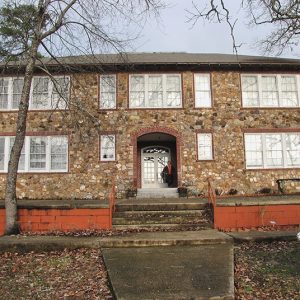calsfoundation@cals.org
Caddo Valley Academy
Caddo Valley Academy (CVA) was founded in Womble (Montgomery County) in 1921. Though the private school was open for a relatively short amount of time, it had a lasting impact on the residents of Womble, which was later known as Norman. Through a blended curriculum of standard academics and biblical teachings, CVA provided a strong educational foundation for its students.
Dr. John Tilman Barr Jr. established CVA. Barr was born in 1886 and devoted much of his life to working with children. Though he was frequently ill, Barr originally aspired to be a lawyer and politician. However, he came to believe that God had instructed him to become a minister and so devoted his life to the Presbyterian Church. Barr’s first placement was in Womble, and he never left. Prior to his arrival and the establishment of CVA, Womble had a public school system that provided basic academic courses through the eighth grade. There was a high school in town, but there were not enough qualified teachers to meet the criteria for accreditation. When Barr privatized the public school, creating CVA, he recruited more qualified teachers so all twelve grades could be taught.
CVA’s curriculum emphasized biblical teachings, though sectarianism was strictly prohibited. Since Womble had students from numerous religious backgrounds and only one schooling option, Barr felt that it would be inappropriate to require the students to follow the Presbyterian faith in order to graduate. Instead, the final four years of the students’ education would include basic Bible classes in addition to the standard curriculum. CVA also offered classes such as piano and home economics in addition to the usual language and math courses. Though the curriculum was expansive, the tuition cost was as much as forty-two dollars less per year than other private schools. CVA kept its tuition at nine dollars a year for junior students and eighteen dollars a year for senior students by relying on church funds and donations for the majority of its financial support.
For the first three school years, CVA conducted classes in the town’s previous school building. In 1924, Barr used money from the Presbyterian Church and other donations to begin construction on a new building for the school. In 1925, CVA moved into the new building and began offering only junior high and high school classes. Many people donated money for the new building, and, though it is not documented, there is some indication that the town was renamed “Norman” in honor of a woman from California who had made a particularly significant donation.
In 1931, the county school board reclaimed control of the school from the Presbyterian Church and Barr. Financial difficulties had always plagued the school, and the students would benefit from the school receiving state money. CVA therefore became Norman Public High School. Barr remained influential in running the public high school and retained his position on the school board. CVA existed for ten years, producing approximately eighty graduates, of which more than half were female, and paved the way toward a stable public high school and improved education for the county.
For additional information:
Blevins, Brooks. “Mountain Mission Schools in Arkansas.” Arkansas Historical Quarterly 70 (Winter 2011): 398–428.
“Caddo Valley Academy Complex.” National Register of Historic Places nomination form. On file at Arkansas Historic Preservation Program, Little Rock, Arkansas. Online at http://www.arkansaspreservation.com/National-Register-Listings/PDF/MN0032.nr.pdf (accessed February 7, 2022).
Manning, Shirley Shewmake. Caddo Valley Academy 1921–1930, Norman High School 1931–1971: School History & Fifty-Year Annual. Mena, AR: 2002.
Laura Choate
Conway, Arkansas
 Mountain Mission Schools
Mountain Mission Schools Caddo Valley Academy
Caddo Valley Academy 




Comments
No comments on this entry yet.